Pentax K-01 Review
Pentax K-01
Pentax's latest designer-developed CSC impresses in many ways, but disappoints in others.
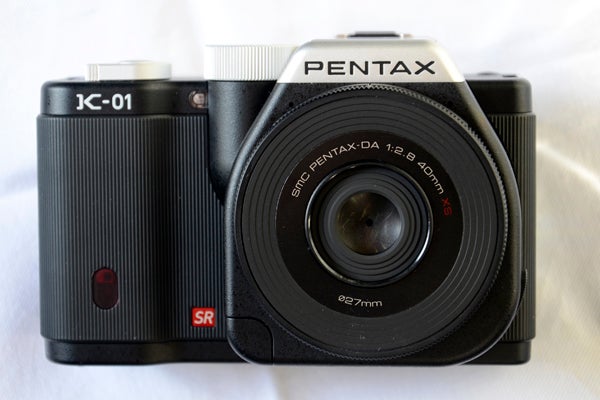
Verdict
Pros
- Bold and unique styling
- Plenty of image-shaping options
- Intuitive and easy-to-use
Cons
- Bold and unique styling
- Sluggish and noisy autofocus
- Expensive compared to its rivals
Key Specifications
- Review Price: £679.99
- 16.2MP APS-C CMOS sensor
- Pentax PRIME M image processor
- ISO 100 - 12,800 (exp. to 25,600)
- 1080p Full HD movies at 30fps
- 11 Custom Image and 7 Digital Filter effects
Following on from the Pentax Q that was launched last year to a somewhat mixed reaction, the K-01 is Pentax’s second compact system camera. Fair to say, however, that the two cameras are very different beasts. Whereas the Q used a regular compact-sized 1/2.3in sensor, Pentax has opted to go down the APS-C route with the K-01 and to give it the same K-mount lens mount that’s used on Pentax DSLRs. Not only that, but in a brave move Pentax has also decided to call in the services of acclaimed Australian designer Marc Newson to help with the design of the K-01 and to that effect it even bears his signature. Of course, Newson has been better known for designing luxury departure lounges for business-class Qantas passengers in the past, so how does this collaboration with Pentax shape up?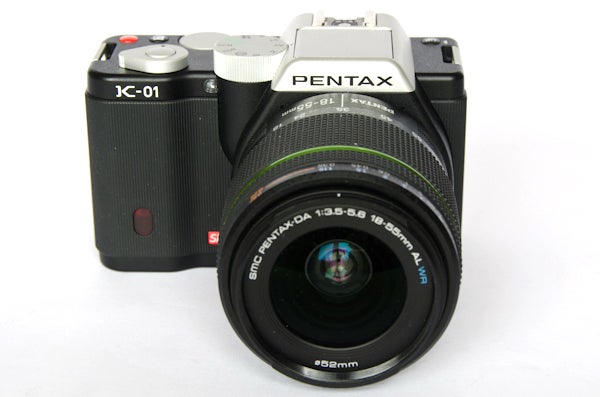
The upshot of this is that, unlike the pocket-friendly Q, the K-01 is a substantially bigger and heavier camera – indeed, it’s practically DSLR like in terms of its overall dimensions. At its heart it uses a newly developed APS-C CMOS chip that produces an effective output of 16.2MP in the default 3:2 aspect, although it’s also possible to lower the resolution to 10MP, 6MP and 2MP, and to alter the aspect to 1:1, 4:3 or 16:9. The K-01 is able to record JPEG (three quality levels), Raw or simultaneous JPEG and Raw images. Sensitivity, meanwhile, stretches from ISO 100 to 12,800 in standard mode, expandable to ISO 25,600 in extended mode.
Complementing the new APS-C sensor is the latest generation of Pentax’s PRIME ‘M’ image processor. This enables the K-01 to shoot continuously at a maximum of 5fps and to capture 1080p Full HD movies at 30fps. Movie sound is recorded in stereo by default and enthusiastic video shooters will also be pleased to discover that there’s an external microphone port on the side of the body.
Elsewhere, and in spite of the relatively unconventional styling, the K-01 follows other recent Pentax digital camera releases, with an especially generous range of image-shaping options in the form of 11 Custom Image image-processing settings and seven Digital Filters. These can be applied to movies as well as stills, either pre- or post-capture. The Custom Image options are especially varied with more unusual options such as ‘Reversal Film’ and ‘Bleach Bypass’ sitting alongside more traditional settings such as ‘Natural’, ‘Vivid’ and ‘Muted’. The digital filters include most of the regular favourites (‘Toy Camera’, ‘Selective Colour’, and ‘Retro’ for example) although oddly there’s no miniaturisation effect on offer.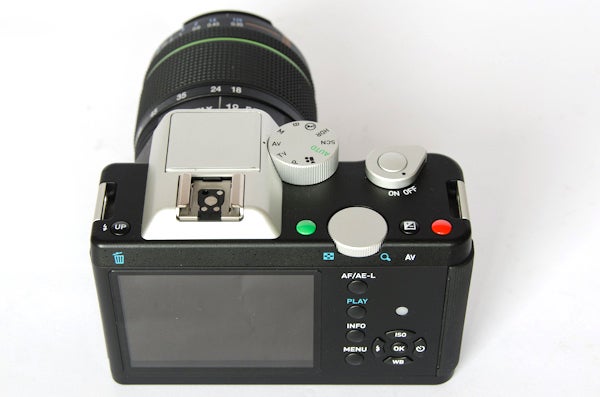
Exposure options include the standard ‘PASM’ settings of Program, Aperture-priority, Shutter-priority and Manual. These are accompanied by an Automatic shooting mode; 19 individually selectable Scene modes; a Forced flash-off mode for when flash is prohibited; a dedicated Bulb setting for long-exposures (a common sight on old-school film SLRs, but somewhat unusual to see on a digital camera), a dedicated HDR mode (the first time this has been included as a standalone option on a Pentax exposure mode dial), and last but not least, the aforementioned Movie mode.
On the back of the K-01 sits a 3inch, 921k-dot LCD monitor that produces a bright, sharp image. There’s no way to attach an electronic viewfinder though, so unless Pentax decide to release an optical attachment in the future, you’ll have to use the rear monitor. We did encounter some problems using the screen in direct sunlight (even with the screen brightness turned all the way up) as it’s quite reflective. In all other situations though the screen provides a detailed and sharp picture to compose and review your images with. We also like how you can easily toggle the display to include detailed shooting information and/or a histogram. On top of the camera there’s a pop-up flash with a GN12 rating, which is opened via a button on the left shoulder. The hot-shoe behind the pop-up is a standard three-pin affair that can accommodate Pentax’s range of flashguns should you want to attach something with a bit more power and range.
So then, given that the K-01 has been designed by an internationally acclaimed designer what’s the general verdict on his, err, design? Well, of course, taste is very much a subjective thing and the overall look (not to mention the dimensions) of the K-01 has already divided opinion among camera enthusiasts. You’ve probably already made up your own mind as to whether you like the look of it or not. Either way, available in a range of colour schemes (yellow/black, all-black and the black/silver model we have here) it certainly stands out from the CSC pack.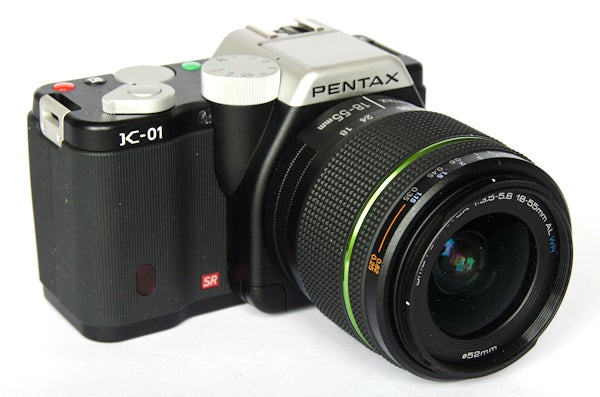
One thing that is indisputable though, is the size of the K-01 – it’s an altogether chunky camera. In fact, we can’t think of a bigger compact system camera currently on the market. The K-01’s not inconsiderable size is almost entirely down to the 59cm depth of the K-01’s body, which in turn has been designed to accommodate the 45.6mm flange distance of the Pentax K-mount system. While Marc Newson has undoubtedly had a hand in the design, it’s not been a completely free hand in this respect.
Pentax claims that the K-mount’s relatively large flange distance has some practical real-world benefits in terms of reduced vignetting. While this might be fine on a DSLR where the expectation of a bigger camera body means it isn’t really an issue, the reality for a compact system camera like the K-01 appears to be that the ‘compact’ part of the equation is rendered null and void.
Still, the added girth does at least give you something substantial to hold on to. The finger grip is squared rather than rounded, and not particularly deep either. That said, the rubberised finish does help to ensure your fingers don’t slide off it. And rather than simply going with the traditional faux leather or smooth rubber finish, Newson has instead opted for thin vertical ridges. Not only does this improve the overall grip, but it also contributes to the K-01’s unique aesthetic. We’re not quite so convinced about the decision to cover the memory-card slot and connectivity panel with this rubber though; it might look good but it feels flimsy and doesn’t offer much protection against dust and dirt either. No doubt this is why the SD memory-card slot has been given an additional snap-shut cover. 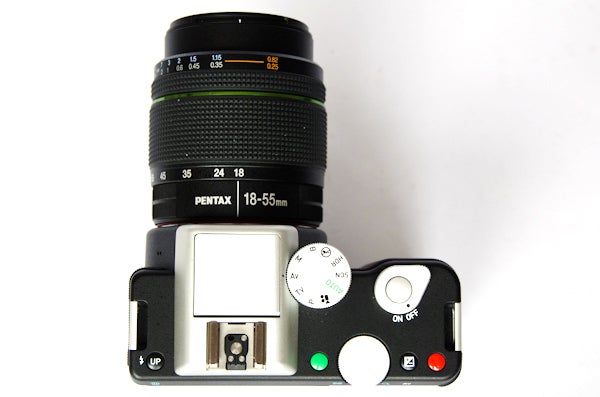
Being a designer-designed camera, many of the camera’s physical buttons have been given something a makeover too. The main mode dial, thumb-wheel and the triangular on/off switch are all constructed from precision-milled aluminium, and both look quite stylish. However, what really catches the eye are the red and green plastic buttons. These can be assigned as you see fit (within certain limits), so that you can, for example, have the red button as the one-touch movie record button while the green plastic button acts as a one-touch Raw recording button. One further design aspect is the lens-release button, which is rather neatly built into the corner of the lens mount itself.
On the back of the camera are a number of additional buttons that can be used to directly access often-used settings such as ISO, WB and Flash. There are also two menu buttons: a main Menu button that accesses the full in-camera menu and an Info button that calls up a kind of quick menu, as seen on other Pentax models. The in-camera menu itself is well laid out and simple enough to navigate with a good choice of customisation options on offer for advanced users. Indeed, one of the principle strengths of the K-01 is that it’s a very easy and straightforward camera to operate and use.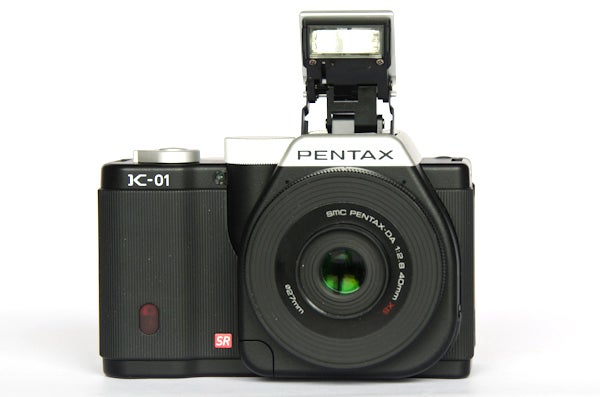
As regards performance, the K-01 is something of a mixed bag. Start-up (ie – the time taken from switching the camera on to it being focused and ready to shoot) clocks in at around 2.5seconds, which isn’t particularly speedy but should be adequate for most people’s needs. Processing times aren’t too bad, although continuous shooting speeds are hampered somewhat by the K-01’s slow autofocus (more on that in a moment). In single-shot drive mode, we were able to shoot five frames inside ten seconds, which equates to 0.5fps. At this setting there is no upper limit on the number of consecutive shots you can take.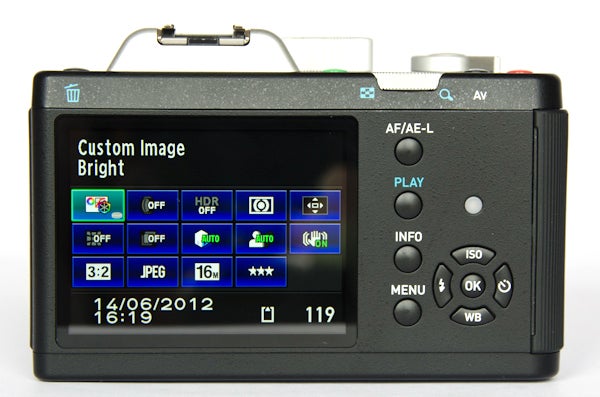
The K-01 offers a choice of two Continuous drive mode options; a 3fps ‘Lo’ setting and a 5fps ‘High’ one. While we were able to record 30 consecutive full-resolution JPEG images in the Low setting without any slowdown, the High setting isn’t able to maintain 5fps for more than about one second, after which it slows to nearer 2.5fps. Processing waits aren’t bad at all though, with the K-01’s processor pretty quick at clearing the backlog once you take your finger off the shutter button.
So far, so good. The main gripe we have with the K-01’s performance, however, is with the lacklustre speed and excessive noise of the K-01’s autofocus system. The 81-point contrast-detect AF is by no means the fastest we’ve seen on a camera of this type, and lags well behind all of its main competitors. Focus hunting (where the camera repeatedly zooms in and out trying to ascertain focus) is common too, even in good light and this can be really quite annoying thanks to the fact that the K-01’s AF system is one of the noisiest we’ve ever encountered.
Indeed, the highly audible whirrs and mechanical grinding sounds the K-01 makes as it attempts to gain focus are, in our opinion, the camera’s single biggest failing. The problem doesn’t appear to be specific to any particular lens either – we experienced exactly the same issue with both the 40mm f/2.8 XS and with an 18-55mm SMC Pentax kit zoom that our review sample came supplied with. Given this, we really can’t recommend the K-01 as a camera to shoot quiet occasions (weddings, christenings etc) with.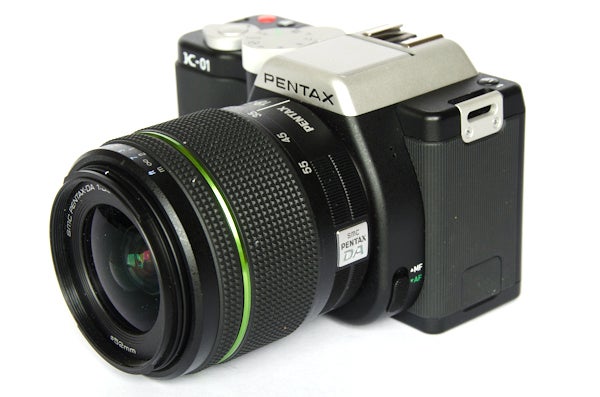
Thankfully, the problems with sluggish and noisy AF are somewhat offset by the high standard of overall image quality produced by the K-01’s 16.2MP sensor – the same (albeit Pentax modified) Sony-made chip that’s found inside the Sony NEX-5n and Nikon D7000, both of which also scored very highly in terms of overall image quality. Not only is this particular CMOS chip able to resolve plenty of fine detail at lower sensitivity settings, it also perform very well at higher sensitivities too, keeping noise under control well into the mid-range ISO settings. The K-01 also offers built-in image stabilisation technology in the shape of Pentax’s propitiatory Shake Reduction and this works well, enabling you to get sharp shots at speeds and extended focal lengths that might otherwise come out blurred.
While Raw shooters are well catered for thanks to the storage of lossless files in the widely accessible Adobe .DNG format, JPEG shooters will also find that the K-01 offers plenty of scope to create your own look with thanks to the various Custom Image and Digital Filter options. Indeed, until you’ve explored them all fully it can sometimes be tricky to decide which one (or indeed combination of the two) will best suit your subject. Still, that’s not a bad dilemma to face – especially if you’re primarily a JPEG shooter looking for a camera that can produce interesting effects straight out of camera without the aid of any image editing software.
The tone and colour produced by the K-01 will vary depending on your choice of Custom Image setting. During our test we tended to stick with the ‘Bright’ Custom Image setting (with the digital filters switched off), which produces images with slightly more punch and clarity than the ‘Natural’ setting, but with less saturation than the ‘Vivid’ setting. We also developed a bit of a soft spot for the ‘Reversal Film’ setting that, as the name implies, mimics the feel and tone of old slide film. Of course, the beauty of having so many options to hand is that you can either find a setting you like and stick with it, or mix and match as the situation demands.
Metering options extend to a multi-segment, centre-weighted and spot options. Pentax doesn’t specify how many pixels the metering module employs, but when used on multi-segment mode we found it to be extremely reliable. The K-01 is able to capture a good dynamic range even with the Highlight and Shadow Correction tools switched off. Should you feel the need to use either of these tools then they are both quite good at what they do, although ultimately you’ll be better off shooting in Raw and processing the image yourself. In addition to these the K-01 also offers built-in software to correct fringing and lens distortion, and while they both work quite well they do prolong processing times quite dramatically. We didn’t encounter any problems of note with the K-01’s Automatic White Balance either, although there are of course options to set colour temperature yourself.
ISO performance is another area where the K-01’s CMOS sensor performs very well. At lower settings of ISO 100 to 400 noise isn’t at issue at all, with mid-range settings of ISO 800 to 1600 also exceptionally clean and free of image degrading noise too. Indeed, noise only starts to make a small impact at ISO 3200, with the setting still perfectly usable to make smaller sized images with. ISO 6400 is the cut-off point in terms of overall quality, with noise much more visible – even at smaller image sizes. This trend accelerates as you hit the top two settings of ISO 12,800 and 25,600 (the latter actually being an ‘extended’ setting). Overall though, the K-01 is undoubtedly one of the better cameras on the market in terms of controlling unsightly noise.
Verdict
The Pentax K-01 is a relatively unique looking compact system camera that has already divided opinion over its bold styling. You’ll either love the look of it, or write it off as a bit of a brick. As this is really a matter of personal taste it’s not for us to say either way. Judged purely on its merits as a digital camera though the K-01 has much going for it but also comes with some fairly major flaws. On the plus side it’s undoubtedly a well featured and easy-to-use camera that’s capable of very good image quality. On the downside, however, the K-01 is pretty bulky for a CSC and the autofocus system is sluggish and far too noisy. All in all then, a brave move from Pentax, but one that requires some refinement before it’s fully worthy of a TrustedReviews ‘Recommended’ badge.

ISO 100 is sharp, detailed and free of noise.

ISO 200 shows no discernable change from ISO 100.

At ISO 400 image quality is still very good with no noticeable noise.

ISO 800 shows the merest hint of softening, but only at 100% and you really have to look hard for it.

By ISO 1600 some softening of the image has begun to occur, but overall quality is still very good.

By ISO 3200 this softening has become more pronounced, especially in shadow areas.

ISO 6400 is the cut-off point in terms of overall quality, with images much more noticeably affected by noise.
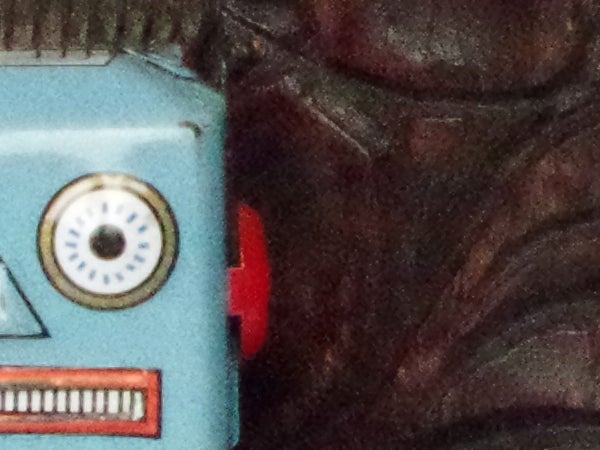
ISO 12,800 and overall image quality is starting to plummet.

The extended setting of ISO 25,600 is best avoided if possible.

Used on the ‘Bright’ Custom Image setting, the K-01 delivers punchy, sharp and vibrant JPEGs straight out of camera.

Detail and dynamic range are both very good.

Should you need to, you can crank up the vibrancy by changing the Custom Image setting.

The ‘Reversal Film’ Custom Image setting does a good job of replicating the look and feel of old-school slide film.

The Shadow Correction tool can be used to boost shadow detail in high-contrast shots.

The Automatic White Balance does a good job, even under mixed lighting.
Trusted Score
Score in detail
-
Value 7
-
Design & Features 7
-
Image Quality 9
-
Build Quality 8
Features
| Camera type | Mirrorless Camera |
| Viewfinder | No |
| Memory card slot | SD |

